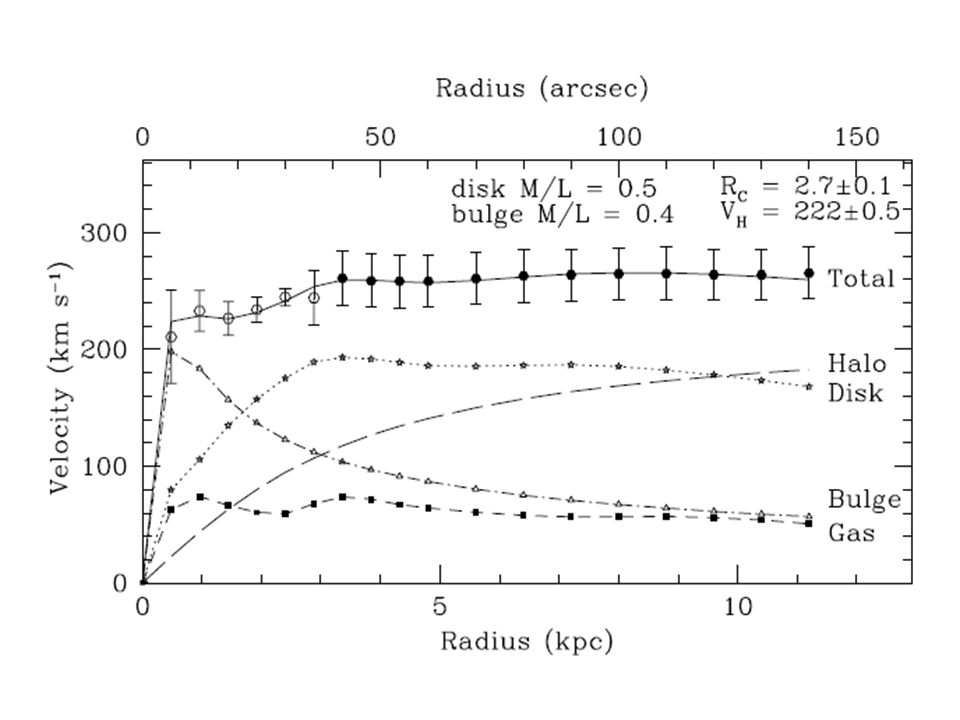Current Research
The Motivation
The formation of structure in the universe is one of the key questions in
astronomy today. Current cosmological models like ΛCDM suggest that all
ordinary luminous matter, such as gas and stars, collapse to form galaxies
inside halos of exotic non-luminous dark matter which interacts only through
the force of gravity. Cosmological simulations allow us to trace the evolution of
small perturbations in an otherwise uniform distribution of dark matter in the early
universe to the complex structure we see in our own Milky Way galaxy today. Despite this,
we still do not fully understand how dark matter influences the formation and evolution
of the gas and stars in galaxies. This connection between ordinary and exotic matter is
a critical aspect of realistic models of galaxy evolution. In an effort to address
fundamental questions regarding the growth and distribution of gas and stars in dark matter
halos, we have undertaken a project aimed at correlating structure and star formation activity
with the dark matter properties of the host galaxy.
The Data
This project uses a statistically representative sample of 44 nearby galaxies built from
existing deep near-infrared Spitzer Space Telescope imaging observations from the
EDGES Survey (see Fig. 1).
We expand upon this initial dataset utilizing a combination of optical imaging and spectroscopic,
near-infrared (NIR), and radio synthesis observations of neutral hydrogen
gas (HI) to perform a comprehensive analysis of the evolution of galactic disks as a function
of dark matter mass, mass in baryonic (or luminous) matter, and environment. Our ability to
synthesize observations at such a wide variety of wavelengths enables us to examine relations
between the fundamental components of galaxies in a way that has never been done before.

Figure 1: The EDGES Survey consists of deep, wide-field infrared imaging observations of a large (92) representative sample of nearby galaxies (black histograms). Constraining the inclination angle between 30° and 68° results in the kinematic sub-sample of 44 galaxies (shaded blue histograms).
The Analysis
The dark matter content and distribution in galaxies is being determined using the well established technique of rotation curve decomposition. This analysis method combines the derived galaxy dynamics from the observed rotation curve with estimates of the baryonic mass distribution in order to derive an estimate of the dark matter distribution of a function of radius (see Figures 2 & 3). The galaxy kinematics are derived from both neutral and ionized gas observations. The HI data comes from radio synthesis observations from new and archival Very Large Array (VLA) and archival Westerbork Synthesis Radio Telescope (WSRT) observations. Newly acquired spectroscopic integral field unit (IFU) observations from SparsePak on the WIYN 3.5m telescope provide ionized gas kinematics in the central regions of galaxies in which the neutral gas column density is low.

Figure 2: (top left) HI (white contours) and CO (red contours) column density overlaid on the Spitzer 3.6μm image. (bottom left) HI velocity field. (right) Rotation curve derived from ionized and neutral gas kinematics.
The contributions from gas and stars to the overall rotation curve are calculated from the gas mass and stellar light surface density profiles. The gas mass surface density is measured from HI and CO (when available) integrated intensity maps. Model rotation curves for the stellar distributions are derived separately for the bulge and disk based on the decomposed NIR light surface density profiles. A constant mass-to-light ratio (M/L) is used to scale the stellar bulge and disk contributions.

Figure 3: Decomposition of the rotation curve from the HI, optical, and NIR data. The total gas (filled squares), stellar bulge open triangles), stellar disk (open stars), and dark matter halo model (dashed line) components are added in quadrature to achieve the best overall fit (solid line) to the observed rotation curve. Open circles represent circular rotation velocities derived from the ionized gas (SparsePak) observations and the filled circles are from the HI (VLA) observations.
In addition to the mass decompositions, we also derive structural properties of the galaxies using optical imaging to supplement the Spitzer 3.6μm. We explore radial trends in surface brightness, color, and equivalent width to search for changes in the dominant stellar population. Current star formation rates (SFRs) are also measured from light in an emission line of hydrogen (Hα), which is commonly used as an indicator of ongoing star formation activity (Fig. 4).

Figure 4: Combined B (blue), R (red), and Hα (pink) image of a sample galaxy taken with the WIYN 0.9m telescope.
In order to understand how galaxies form we need to understand how the dark matter halos influence the baryons which form the gas and stars. The connection between star formation rate and dark matter fraction, for example, will highlight the impact of dark matter on the gravitational stability of the galaxy disk either supporting or hindering star formation. Similarly, correlations between the distribution of dark matter and radial gradients in the properties of the stellar components will better constrain disk formation scenarios, such as inside-out growth models.
Last modified: August 2015